Prevention of New Onset Diabetes after Transplantation Using Bariatric Surgery
A. Bailey, Y. Kim, S. Woodle, S. Shah, F. Paterno, M. Cuffy, T. Diwan.
Transplant Surgery, University of Cincinnati, Cincinnati, OH.
Meeting: 2018 American Transplant Congress
Abstract number: 338
Keywords: Insulin, Kidney transplantation, Obesity, Post-transplant diabetes
Session Information
Session Name: Concurrent Session: Kidney: Cardiovascular and Metabolic - 2
Session Type: Concurrent Session
Date: Monday, June 4, 2018
Session Time: 4:30pm-6:00pm
 Presentation Time: 4:42pm-4:54pm
Presentation Time: 4:42pm-4:54pm
Location: Room 303
New onset diabetes after transplantation (NODAT) is a common complication, occurring 20-36% after renal transplant historically and 15.8% at our institution. Obesity is a known modifiable risk factor for diabetes. The aim of our study was to determine if treatment of obesity with bariatric surgery prior to kidney transplantation (Ktx) decreased the incidence of NODAT.
Methods A retrospective chart review was performed for patients that underwent Ktx after laparoscopic sleeve gastrectomy (LSG), from 2011 to 2017 at our institution. Immunosuppression consisted of thymoglobulin induction, tacrolimus, mycophenolate mofetil maintenance therapy and a rapid steroid taper over 7 days.
Results 25 patients were analyzed with an mean age of 54.7 (range 40-72 years). The mean BMI prior to LSG was 39.7kg/m2 (range 37-42kg/m2). The mean BMI post LSG and prior to Ktx was 30.18 kg/m2 (range 25.84- 37.8kg/m2). The mean BMI at 1 year follow up post Ktx was 30 kg/m2 (range 27.76 to 44.41kg/m2). There were 9 non-diabetic patients prior to LSG and renal transplantation. No patients (0/9) developed NODAT after Ktx with an mean follow up of 1271 days (range 365-2039 days). Fifteen patients had Type II DM prior to LSG; 9 out of 15 (60%) had no insulin requirement after LSG. Four patients with pre-LSG Type 2 DM continued to be insulin free post Ktx. The mean insulin requirement (figure 1) decreased after LSG, from 35.6 units to 8.6 units (p = 0.003). The mean insulin requirement post-Ktx was 18.6 units compared to 35.6 units prior to bariatric surgery (p = 0.04). The mean time between LSG and Ktx was 480 days (range 140-1245 days). There was no significant correlation between time between LSG and Ktx on NODAT or insulin requirements.
Conclusion Obesity modification using bariatric surgery prior to Ktx resulted in 0 pre-Ktx, non-diabetic patients, developing NODAT. In addition, patients with insulin dependent Type 2 DM pre-LSG had significant reduction in insulin requirements post-LSG that were sustained after Ktx, with some requiring no insulin therapy. The use of bariatric surgery in obese renal transplant candidates has the potential to decrease the incidence of NODAT.
CITATION INFORMATION: Bailey A., Kim Y., Woodle S., Shah S., Paterno F., Cuffy M., Diwan T. Prevention of New Onset Diabetes after Transplantation Using Bariatric Surgery Am J Transplant. 2017;17 (suppl 3).
To cite this abstract in AMA style:
Bailey A, Kim Y, Woodle S, Shah S, Paterno F, Cuffy M, Diwan T. Prevention of New Onset Diabetes after Transplantation Using Bariatric Surgery [abstract]. https://atcmeetingabstracts.com/abstract/prevention-of-new-onset-diabetes-after-transplantation-using-bariatric-surgery/. Accessed December 27, 2025.« Back to 2018 American Transplant Congress

